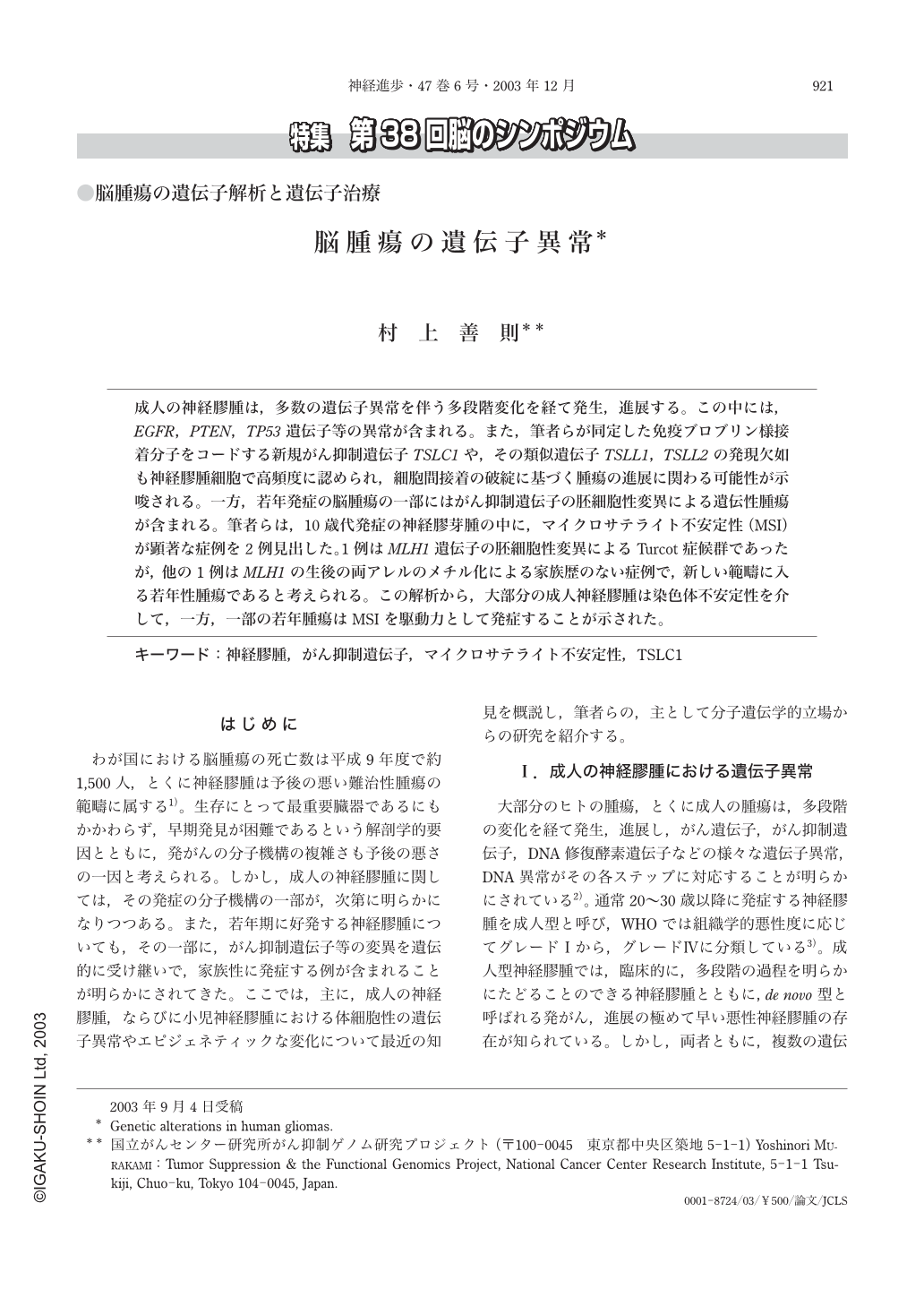Japanese
English
- 有料閲覧
- Abstract 文献概要
- 1ページ目 Look Inside
成人の神経膠腫は,多数の遺伝子異常を伴う多段階変化を経て発生,進展する。この中には, EGFR , PTEN , TP53 遺伝子等の異常が含まれる。また,筆者らが同定した免疫ブロブリン様接着分子をコードする新規がん抑制遺伝子 TSLC1 や,その類似遺伝子 TSLL1 ,TSLL2 の発現欠如も神経膠腫細胞で高頻度に認められ,細胞間接着の破綻に基づく腫瘍の進展に関わる可能性が示唆される。一方,若年発症の脳腫瘍の一部にはがん抑制遺伝子の胚細胞性変異による遺伝性腫瘍が含まれる。筆者らは,10歳代発症の神経膠芽腫の中に,マイクロサテライト不安定性(MSI)が顕著な症例を2例見出した。1例は MLH1 遺伝子の胚細胞性変異によるTurcot症候群であったが,他の1例は MLH1 の生後の両アレルのメチル化による家族歴のない症例で,新しい範疇に入る若年性腫瘍であると考えられる。この解析から,大部分の成人神経膠腫は染色体不安定性を介して,一方,一部の若年腫瘍はMSIを駆動力として発症することが示された。
はじめに
わが国における脳腫瘍の死亡数は平成9年度で約1,500人,とくに神経膠腫は予後の悪い難治性腫瘍の範疇に属する1)。生存にとって最重要臓器であるにもかかわらず,早期発見が困難であるという解剖学的要因とともに,発がんの分子機構の複雑さも予後の悪さの一因と考えられる。しかし,成人の神経膠腫に関しては,その発症の分子機構の一部が,次第に明らかになりつつある。また,若年期に好発する神経膠腫についても,その一部に,がん抑制遺伝子等の変異を遺伝的に受け継いで,家族性に発症する例が含まれることが明らかにされてきた。ここでは,主に,成人の神経膠腫,ならびに小児神経膠腫における体細胞性の遺伝子異常やエピジェネティックな変化について最近の知見を概説し,筆者らの,主として分子遺伝学的立場からの研究を紹介する。
Adult gliomas, like many other solid tumors, develop and progress towards malignancy through accumulation of multiple genetic alterations. These include amplification of the EGFR gene and inactivation of the PTEN or TP53 genes. We found that the expression of the TSLC1, that we previously identified as novel tumor suppressor in lung cancer, as well as the expression of its homologous genes, TSLL1 and TSLL2, that belong to the immunoglobulin-like cell adhesion molecules, was often lost in glioma cell lines, suggesting that alterations of these genes are involved in the progression of gliomas. On the other hand, it is known that portions of childhood gliomas develop as familial tumors caused by the germline mutations in several tumor suppressor genes. We found high-frequent microsatellite instability(MSI-H)in two of the 80gliomas examined, while the other 78gliomas showed microsatellite stable(MSS)phenotype. Both of the two MSI-H tumors were glioblastomas which developed in teenage patients. One of the patient was diagnosed as having Turcot's syndrome and had a germline mutation in the hMLH1 gene. The other patient had neither a family history nor a past personal history of malignancy. Although no mutation in the mismatch repair genes was detected in the tumor of this patient, the level of expression of the hMLH1 gene was markedly decreased and the promoter sequence of the gene was highly methylated. In the tumor of this patient, the PTEN1 gene, one of the genes carrying microsatellite sequences in their coding regions, was altered by a slippage mutation within 5 adenine repeat sequences. These findings indicate that the genetic or epigenentic inactivation of the hMLH1 gene is involved in a subset of early-onset gliomas and the PTEN1 gene could be a downstream target for mutation as observed in glioblastoma without MSI.

Copyright © 2003, Igaku-Shoin Ltd. All rights reserved.


